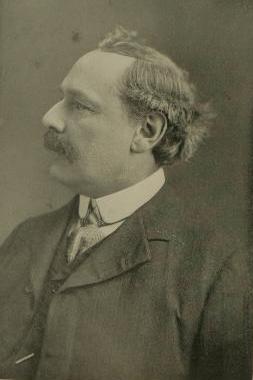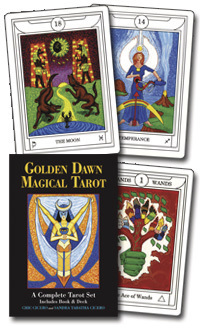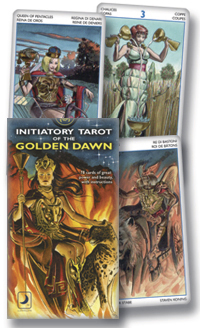Tarot—Pips or Pics?
Most people now accept that the fact that the Tarot cards do not go back to ancient Egypt, Atlantis, or some other source from thousands of years ago. Most knowledgeable Tarot researchers also acknowledge that the Tarot didn’t evolve out of the Kabalah. In fact, the associations of the Kabalistic Tree of Life came long after the Tarot began. They were popularized by Eliphas Levi during the nineteenth century’s “French Occult Revival.”
But when it comes to the designs of the Minor Arcana cards—the ones that are most like a deck of playing cards—most people think they’re all pictorial and dismiss any deck that doesn’t have images on every card.
In actuality, it was only about 100 years ago that the first fully-pictorial deck was published. This, of course, was the deck drawn by Hermetic Order of the Golden Dawn member Pamela Coleman Smith under the guidance of fellow G.D. member A.E. Waite. Published by Rider and Sons, the deck rapidly became popular. This was not only due to Smith’s wonderful artwork on each card, but because Waite wrote one of his most accessible books, The Pictorial Key to the Tarot, which specifically gave information on how to use his deck. The combination of book and deck was unstoppable, and it has become the most popular Tarot deck around, considered by many to be the base against which all other Tarot decks should be measured.
As an aside, I find it interesting that most people ignore that in his book Waite clearly states that he is not revealing the inner secrets of Tarot. Specifically, he writes:
The fact remains, notwithstanding, that a Secret Tradition exists regarding the Tarot, and as there is always the possibility that some minor arcana of the Mysteries may be made public with a flourish of trumpets, it will be as well to go before the event and to warn those who are curious in such matters that any revelation will contain only a third part of the earth and sea and a third part of the stars of heaven in respect of the symbolism. This is for the simple reason that neither in root-matter nor in development has more been put into writing, so that much will remain to be said after any pretended unveiling. The guardians of certain temples of initiation who keep watch over mysteries of this order have therefore no cause for alarm.
 A. E. Waite
A. E. Waite
He was clearly keeping some secrets, specifically those of the Golden Dawn. Later, Paul Foster Case put the Hebrew letters right on the Major Arcana cards. At that time this was a GD secret, and he got into trouble for it.
Three Golden Dawn Decks
Smith and Waite’s deck was a variation of the Golden Dawn’s Tarot. Waite referred to it as being “rectified.” So what deck did the Golden Dawn use? The simplest answer is: none. You were expected to draw your own version of the Tarot based on a set of instructions. Case, in his group the Builders of the Adytum, only offered a deck with outlines. You were expected to color in the cards yourself according to instructions. When I took the BOTA lessons I found this incredibly valuable. A colored version of Case’s deck was not made available until long after his death. The BOTA deck’s Minor Arcana has pips, not pictures. So in that it’s closer to the Golden Dawn original design, but it is not the Golden Dawn deck.
Today, there are three decks claiming to be the Golden Dawn deck that are widely available. Each has its own value.
The first of these was created by Robert Wang and has some interesting history. Israel Regardie, while a member of the Golden Dawn, had created his own deck. Unfortunately, it was stolen and then either recreated by Regardie or returned to him. The stories I have heard were mixed. In any event, Regardie loaned his deck to Mr. Wang so that Wang could create a new version of the deck. Regardie told me that he felt Mr. Wang simply used Regardie’s line drawings. It appears as if Wang also colored it with watercolors. The Minor Arcana, per the Golden Dawn instructions, are all pips.
I used this deck for years. I even noted some minor discrepancies between the art and the descriptions in the Golden Dawn documents. I would add that Wang’s book on the Tarot, The Qabalistic Tarot, is one of the best books ever on these subjects.
Regardie told me that he was not satisfied with the deck, and he gave his support to a new version drawn by Sandra Tabatha Cicero. The Golden Dawn Magical Tarot is filled with brilliant colors and, in my opinion, far more accurately depicted the concepts of the Golden Dawn. It also features an extra version of the Temperance card of the Major Arcana as required by one of the Golden Dawn rituals. That makes this deck additionally unique and a must for Golden Dawn group work. With instructions by Ms. Cicero and her husband, Chic Cicero, this quickly became my “go-to” Tarot deck. Following the Golden Dawn standard, it, too, has pip cards for the Minor Arcana.
The third deck only came out last year. Giordano Bertia, a Tarot expert, gave the Golden Dawn design instructions to artist Patrizio Evangelisti. Without seeing any other Golden Dawn deck, Evangelisti created The Initiatory Tarot of the Golden Dawn. Evangelisti is a comic book artist, and his sense of composition, color, and shading shows. This deck is absolutely breathtaking in beauty and line. However, rather than follow the GD instructions for the Minor Arcana cards, he uses the Waite deck as a model. The Minors are all pictorial.
Pips vs. Pics
This brings up the inevitable question. Which is better, a minor arcana that is pictorial or one that just shows the number of the card (i.e., five swords on the Five of Swords)? My answer: Well, it depends.
In my experience, having just pips on the Minor Arcana cards requires more work on the part of the user. He or she must memorize the meanings of the cards as there’s no picture to stimulate your imagination. In my readings I use a combination of numerological and elemental associations. When you have pictures on the cards, it may be easier to come up with a meaning, but for me it also limits you to a narrow band of meanings based around the image.
For me, this is incredibly important for meditation. I don’t want the limitations of a pictorial Minor Arcana. I want my mind to be able to freely roam.
When I’m giving a series of Tarot readings, however, I prefer a pictorial Minor Arcana for a couple of reasons. First, the picture is right there and it’s easy to come up with a meaning. Second, clients who are used to seeing versions of the Smith-Waite deck in movies and on TV expect to see a pictorial Minor Arcana, and I want to fulfill their expectations.
To sum up:
- For ritual work I use The Golden Dawn Magical Tarot.
- For individual readings I also use The Golden Dawn Magical Tarot.
- For meditation I use The Golden Dawn Magical Tarot.
- For a series of readings I use The Initiatory Tarot of the Golden Dawn.
Which Should You Use?
Rather than saying you should use a particular deck, I think it’s important to recognize that the Tarot is filled with symbolism. As such, to be an effective spiritual and magickal tool it needs to appeal to your conscious and unconscious minds. I suggest looking at several decks and choosing the one that most appeals to you. There is no right and wrong in this choice unless you choose a deck you don’t like.
Which do you prefer, a pictorial or non-pictorial Minor Arcana?
Announcements
Something new and a reminder…
First, I wrote a guest blog post about pet familiars and psychic pets for my friend, Devin O’Branagan. You can read it HERE. Devin has written some very exciting Pagan books such a Witch Hunt and Glory, and you can find out more about them on her site. Thank you, Devin, for allowing me to make the blog post!
Second, later this week I’ll be appearing at Pantheacon in San Jose, California. There will be a couple of thousand magickal people taking over the DoubleTree hotel where there will be lots of rituals, performances, and workshops. Presenters include myself, Raven Grimassi, Chic and Sandra Tabatha Cicero, Ellen Evert Hopman, Mary Greer, Amber K and Azrael Arynn K, Rachel Pollack, Lon Milo DuQuette, Christopher Penczak, Brandy Williams, Melanie Marquis, Z Budapest, Lupa and many others. If you can, get to San Jose next weekend. You’ll experience the event of the year!












I have used the Voyager tarot deck exclusively for many years, and have found that the extremely pictorial images help me interpret their meaning for the individual or situation I am working with. They stimulate many different bits of my senses, memory and symbolic information in my mind so that I can intuit a variety of possibilities as I am reading, then correlate them to each other and bring it deeper as I go. It’s a very empathic process, and I am very visual and intuitive, so the simpler cards never allowed the depth and accuracy I have found using the Voyager deck.
On the subject of Pic’s Vs Pips;
.
My own experiance was that I found Tarot simply impenetrable with a pips deck; but after reading with pictorial decks a few years I was (and am) able to pick up a pips deck and read it; there is a freedom in this because in the course of a given reading I might call on the 5 of Cups from the Robin wood, or the 7 of Wands from the Gendron; or … and so on;
.
There is a tremendous freedom in this, when you stop chasing the Perfect deck and realize your ideal deck probably exists in your own minds eye.
[…] Read the full article […]